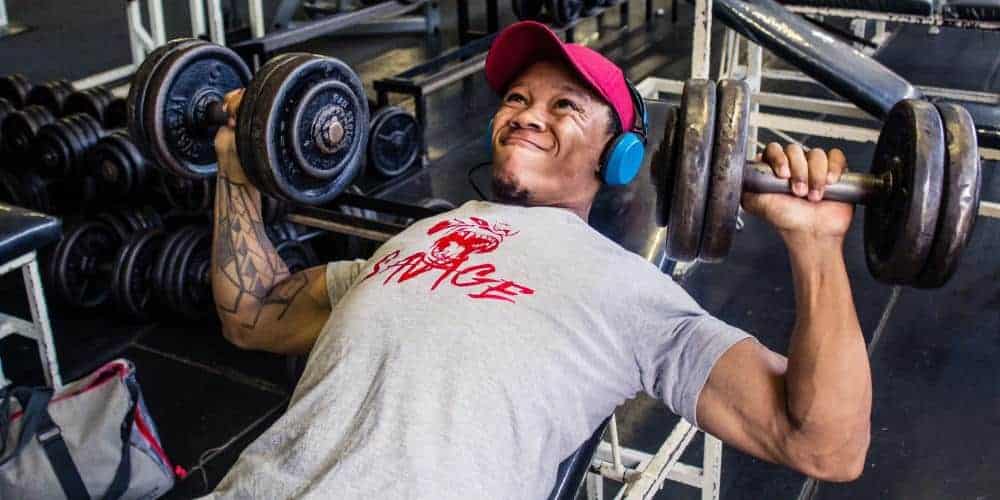
Continuing the “basics” of weight training series, today’s topic is all about Progression.
What actually is Progression in weight training? How does it work? And what do you need to know about it in order to achieve your goals?
To begin with, Progression is the confirmation of a suitable training stimulus.
Progression basically means nothing other than improving your workout performance.
Specifically, this translates into more weight, more repetitions or even shorter breaks. If possible you should prefer
Why is progression so important?
Because progression is the overriding goal in weight training. The (long-term) progression indicates the confirmation of a suitable training effect.
In other words, if you train correctly and make sure that other essential frameworks (such as rest or nutrition) are aligned
So if you can not improve over a longer period, either your diet, your recovery or even your training is not as good as it should be.
Maybe you’re doing too much, maybe too little. Maybe you do not consume enough calories or you’re just putting too much stress into your everyday life.
Simply put, progression gives you feedback on whether you’re on the right path.
What would be the explanation for that?
A larger muscle is always a stronger muscle, provided the conditions remain constant.
So if you have not gotten better over a longer period of time, you probably could not build muscle. Because
But you should never increase the weight at the expense of your technique since at a certain level of improper technique the training effect of the exercise is reduced further and further. Moreover, this leads to a higher risk to injuries.
Accordingly, a deviation from clean technique also means a departure from the technique with the greatest training effect.
In addition, you have not become stronger but have just simplified the exercise and so you have of course no confirmation of a suitable training stimulus.
So always make sure the training effect is maximal for your muscles and do not fall for a “fake progression“.
Progression can, as mentioned above, take place in various ways.
You can use more weight or simply complete more reps per set. Lower workloads (distance to muscle failure), less falsification (of the technique) or shorter breaks.
A lower load means nothing else
In turn, muscle failure means that you can not complete another repetition on your own. Of course, as your load lowers, your performance has naturally increased as you could have done more reps.
But why can we use the latter progression methods only to a certain extent?
At some point, your break times will be too low to refill your energy stores sufficiently (adenosine triphosphate, better known as ATP).
Furthermore, your stamina can become a limiting factor and, in the worst case, cause injury as your concentration drops more.
In addition, it may happen that you can not keep up with breathing and thus can not maintain the necessary tension during basic exercises.
If you want to look better or get stronger, you also have to treat your “strength training” as “strength training”.
Just do cardio if you want to burn calories.
If you have learned the correct technique, less faking is no longer possible.

Ok, and why can not we keep lowering the load?
At some point, the stimulus is simply too low to continue progression. Would be too good if we could someday train 20 repetitions before muscle failure and still build rock-solid muscles.
Increasing the number of repetitions, ie the only method of progression, is also only possible to a limited extent, as the focus of the training changes after a certain repetition range.
If you suddenly complete 30 instead of 8 reps, you will not be training 100% towards building muscle. Your body will then make other adjustments in order to adapt to this specific load.
A higher lactate tolerance or a better energy supply, for example, would be a possible adaptation.
So you notice: you can not avoid the increase in weight in the long term. It is by no means about becoming the strongest, but only the strongest version of yourself.
The rate of progression, that is, how fast you should increase or even at all, depends heavily on your level of training.
It’s not about benchmarking with other people or how much you bench, squatting or deadlifting in terms of numbers, it’s about ranking your performance relative to your genetic limit.
With
Just imagine a person who has very short arms and weighs 120kg. Due to the very small range of motion and the high body weight should be 100kg bench press (even as a beginner) not a problem at all.
Now you take again a woman with long arms and a body weight of 50kg. The long arms move the weight over a much wider range of
Of course, her delicate 50kg does not make the whole thing any easier. With 100kg on the bench, she would clearly be a true professional.
Both may be the same in absolute terms, but they have very different demands on the rate of progression.
Why does the speed of progression depend on the level of training?
Although large muscles may look more aesthetically pleasing to a certain extent, they are evolutionary in nature, both for growing and sustaining and much for survival in the wild.
In the past, since there were no supermarkets with infinite amounts of food, as far as I know, the body had to curb unnecessary muscle growth in order to avoid excessive energy consumption and thus ensure survival.
So your body only builds muscle when it really needs it.
Presumably, he thinks you’re defending your family against a saber-toothed tiger, lugging a slain mammoth, or doing anything heroic, and not wanting to impress the other sex on the beach or win a bodybuilding competition.
Anything you do in the beginning will put a lot of strain on your body. As a result, your body’s adaptation will also be quite strong, and you will become more agile or muscular.
As your level rises, it inevitably means that you have adjusted more to the load and that load is no longer earth-shattering.
The result: Muscle and strength gains are getting smaller and smaller.
With each step forward, the next step decreases. So you can, if you do many things right, in the first 2-3 years already come very far.
After that, the wheat separates from the chaff, because you have to train much smarter and sometimes harder to get further progress.
With increasing training levels, many small mistakes can even completely diminish your progress.
In the beginning, 0.5kg less muscle in the year is not really tragic, you build up 7.5kg instead. In the case of an experienced athlete, however, this 0.5kg would be the total muscle gain for a whole year.
That’s why you see a lot of dedicated athletes who have always looked the same for years. Their small errors add up so that the entire muscle building process can go close to zero.
Of course, progression can also be determined optically or based on body data. Images, scopes, a DEXA scan or other measuring methods would be suitable for this. But there is one big problem: even the most accurate measurement methods are relatively inaccurate.
Larger scopes can falsify your muscle mass gains, by more inches on the tape, due to the increasing body fat percentage. But even the DEXA Scan is not capable of detecting minor changes in lean mass.
We do not even need to talk about body fat scales and Co. because they can show extremely large measurement errors.
In addition to the training performance, pictures would be the best way to measure progression. Pay attention to the same recording conditions, so that the result is not distorted.

Progression rate
The amount of progression depends on your level of training.
Now that we know that the rate of progression depends on our level of training, we have to ask ourselves what level of training we currently have. You can use the following criteria as a guide to assessing your level of training:
Beginners: You can increase from unit to unit.
Advanced Athlete: You can increase from week to week.
Professional: You can increase from month to month or year to year.
Of course, these are not fixed guidelines, but they give you clues that you can orientate yourself and thus properly classify.
At a certain level, you can be happy if you can bench, lift or squat “only” 5kg more in one year.
So you see no absolute power values or specific body data, but the pure potential, which is still hidden in you.
Because of this, a person who has been training for over 10 years can also be a complete beginner.
Put simply, the easier you can make progress, the further you are from your genetic potential. Accordingly, you can and must of course make another claim to the rate of your progression.
I hope you have now understood the importance of progression. If you do not monitor your progress, it may be possible for you to walk around for years.
This phenomenon can be seen in any gym in the world: There is always the guy who puts in a lot of effort in the gym, but after 10 years of training still looks and performs the same as on the first day.
If you do not want to be this guy, be honest with yourself and your progression. If you do not make any progress, then you know exactly that either your training or your recovery is in need of improvement.
Remember: A fault confessed is half redressed.
Finally, it should be mentioned that progression does not necessarily represent the best possible progression. Just because you have increased by 5kg in a year, it does not mean that you could not have increased by 10kg.
Take home
Today we’ve talked all about what Progression is in Weight Training and how it does work. Here’s a little recap for you:
- Progression gives you feedback on whether you are on the right track.
- Progression depends on your personal training level.
- Whether you are a beginner, an advanced athlete or even a profit, it always depends on your genetic limit.
- The more advanced you are, the slower the progression becomes.
- There are several types of progression, of which weight gain is the best solution over the long term.
- Do not be fooled by your “fake progression” and always pay attention to your technique.
- Any progression does not have to be the best possible progression.
- Take pictures of yourself and analyze your training performance so you can always compare
How do you measure and monitor your progression? Are you a beginner, advanced athlete or pro?
Leave a comment below and engage with us!
Thanks as always for the read,
Claas




